Lights Over lapland is excited to announce that Autumn Aurora Adventures are available for immediate booking! Reserve your adventure of a lifetime in Abisko National Park, Sweden today! | | |
FATHER'S DAY ROCKET LAUNCH: On June 18th, NASA will try for the 8th time to launch a sounding rocket from Wallops Flight Facility in Virginia, creating a colorful display of artificial clouds high above the eastern seaboard of the USA. Previous launches have been aborted because of, e.g., high winds, clouds, and boats in the hazard area. The launch window is from 9:05 to 9:20 pm Eastern Time. Blue-green and red vapors may be visible from New York to North Carolina between 4 and 5.5 minutes after launch. Free: Aurora Alerts
RETURN OF THE NOCTILUCENT CLOUDS: A mesospheric heat wave that wiped out noctilucent clouds (NLCs) in early June is subsiding. As temperatures drop 83 km above Earth's surface, summertime wisps of water vapor are rapidly crystallizing around specks of meteor smoke with visible results. The NLCs are back. Allan Trow photographed their silvery tendrils over Anglesey, N. Wales, UK, on June 16th:
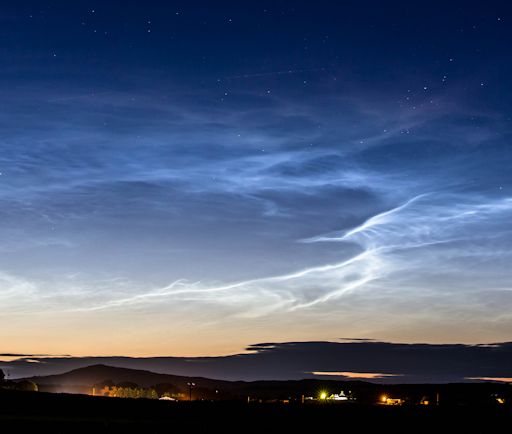
"The clouds were so expansive, I had to stitch two images together to capture the complete display," says Trow.
This is an unusually late start to the summer season for NLCs, and no one can say for sure what will happen next. However, researchers working with NASA's AIM spacecraft, which studies NLCs from Earth orbit, believe the clouds will quickly intensify as the 2nd half of June unfolds.
When noctilucent clouds first appeared in the 19th century, you had to travel to Arctic latitudes to see them. In recent years, however, they have intensified and spread with sightings as far south as Colorado and Kansas--a development that might be related to climate change. Observing tips: Look west 30 to 60 minutes after sunset when the sun has dipped ~10 degrees below the horizon. If you see luminous blue-white tendrils spreading across the sky, you may have spotted a noctilucent cloud.
Realtime Noctilucent Cloud Photo Gallery
FATHER'S DAY AT THE EDGE OF SPACE: On June 10th, the students of Earth to Sky Calculus flew a cosmic ray balloon to the edge of space, collecting another data point for their atmospheric radiation monitoring program. To support the flight, Spaceweather.com reader Caryl Anne Crowne bought her husband Erick a Father's Day gift. She sent his picture to the stratosphere:
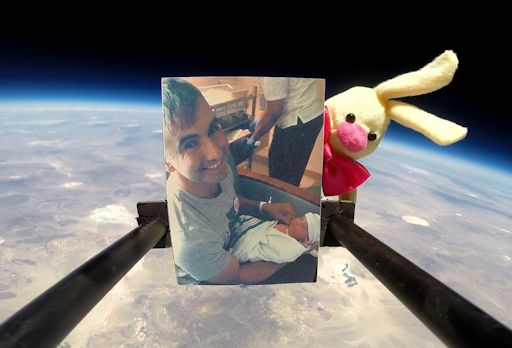
Pictured alongside Erick is their newborn daughter Vayda. She will receive the bunny! "I'm really excited to share this with Erick for his first Father's Day!" says Caryl Anne, who will also be giving him a complete 2 hour HD video of the flight.
Readers, if you would like to support our student research program and send your own picture to the stratosphere, you can buy a Ticket to Space discounted for Father's Day. In fact, there's still time to give it as a Father's Day gift because we can email the certificate to you on June 18th.
Happy Father's Day, Erick!
Far Out Gifts: Earth to Sky Store
All proceeds support hands-on STEM education
POLAR MESOSPHERIC SUMMERTIME ECHOES: High above the Arctic Circle in Lofoten, Norway, researcher Rob Stammes cannot see noctilucent clouds through the glare of the midnight sun. Nevertheless, he knew they had returned. How? He heard them! "On June 15th, my VHF radio system recorded polar mesospheric summertime echoes (PMSEs)--a sign of noctilucent cloud activity," he explains.
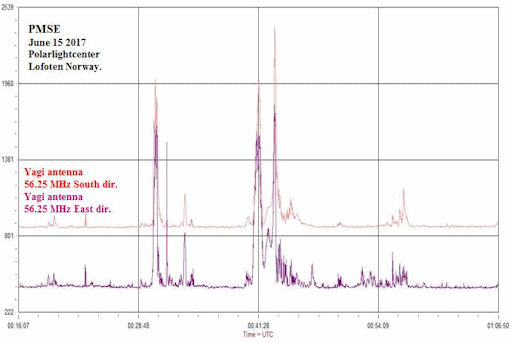
PMSEs are terrestrial radio stations reflected from an altitude of 80 km to 90 km. That part of Earth's upper atmosphere is the mesosphere--the same place noctilucent clouds are found. The exact cause of PMSEs is not yet known; theorists have proposed explanations ranging from steep electron density gradients and "dressed aerosols" to gravity waves and turbulence. The echoes are often accompanied by visible NLCs.
"I normally use my VHF receiving system for signals from auroras and meteors," says Stammes. But there were no meteor showers or geomagnetic storms in progress at the time. "This event was much more like a PMSE, which I have detected many times in previous seasons."
He detected
another episode of radio echoes on June 16th--confirming what is now obvious to the naked eye for many northern sky watchers: NLC season is finally underway. Stay tuned for more PMSEs.
Realtime Space Weather Photo Gallery
Realtime Aurora Photo Gallery
Realtime Comet Photo Gallery
Every night, a network of
NASA all-sky cameras scans the skies above the United States for meteoritic fireballs. Automated software maintained by NASA's Meteoroid Environment Office calculates their orbits, velocity, penetration depth in Earth's atmosphere and many other characteristics. Daily results are presented here on Spaceweather.com.
On Jun. 17, 2017, the network reported 12 fireballs.
(11 sporadics, 1 Northern June Aquilid)

In this diagram of the inner solar system, all of the fireball orbits intersect at a single point--Earth. The orbits are color-coded by velocity, from slow (red) to fast (blue). [Larger image] [movies]
Potentially Hazardous Asteroids (
PHAs) are space rocks larger than approximately 100m that can come closer to Earth than 0.05 AU. None of the known PHAs is on a collision course with our planet, although astronomers are finding
new ones all the time.
On June 17, 2017 there were 1803 potentially hazardous asteroids.
 |
Recent & Upcoming Earth-asteroid encounters: | Asteroid | Date(UT) | Miss Distance | Velocity (km/s) | Diameter (m) |
| 2017 LE1 | 2017-Jun-15 | 20 LD | 6.4 | 25 |
| 2010 VB1 | 2017-Jun-16 | 10.3 LD | 8.3 | 81 |
| 2017 LX | 2017-Jun-16 | 2.8 LD | 20 | 20 |
| 2017 LV | 2017-Jun-18 | 6.8 LD | 10.7 | 21 |
| 471984 | 2017-Jun-18 | 19.1 LD | 7.7 | 102 |
| 2017 LW | 2017-Jun-20 | 15.7 LD | 3.5 | 28 |
| 441987 | 2017-Jun-24 | 7.9 LD | 12.7 | 178 |
| 2017 BS5 | 2017-Jul-23 | 3.1 LD | 5.8 | 54 |
| 2014 OA339 | 2017-Aug-13 | 12.3 LD | 10 | 47 |
Notes: LD means "Lunar Distance." 1 LD = 384,401 km, the distance between Earth and the Moon. 1 LD also equals 0.00256 AU. MAG is the visual magnitude of the asteroid on the date of closest approach. | | Cosmic Rays in the Atmosphere |
Readers, thank you for your patience while we continue to develop this new section of Spaceweather.com. We've been working to streamline our data reduction, allowing us to post results from balloon flights much more rapidly, and we have developed a new data product, shown here:
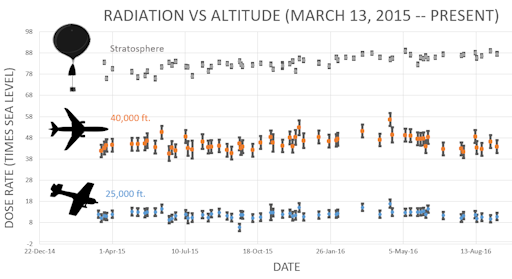
This plot displays radiation measurements not only in the stratosphere, but also at aviation altitudes. Dose rates are expessed as multiples of sea level. For instance, we see that boarding a plane that flies at 25,000 feet exposes passengers to dose rates ~10x higher than sea level. At 40,000 feet, the multiplier is closer to 50x. These measurements are made by our usual cosmic ray payload as it passes through aviation altitudes en route to the stratosphere over California.
What is this all about? Approximately once a week, Spaceweather.com and the students of Earth to Sky Calculus fly space weather balloons to the stratosphere over California. These balloons are equipped with radiation sensors that detect cosmic rays, a surprisingly "down to Earth" form of space weather. Cosmic rays can seed clouds, trigger lightning, and penetrate commercial airplanes. Furthermore, there are studies ( #1, #2, #3, #4) linking cosmic rays with cardiac arrhythmias and sudden cardiac death in the general population. Our latest measurements show that cosmic rays are intensifying, with an increase of more than 13% since 2015:
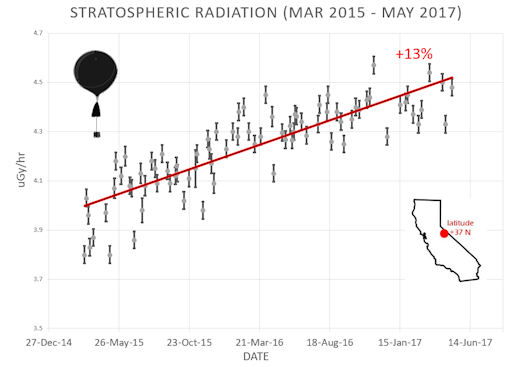
Why are cosmic rays intensifying? The main reason is the sun. Solar storm clouds such as coronal mass ejections (CMEs) sweep aside cosmic rays when they pass by Earth. During Solar Maximum, CMEs are abundant and cosmic rays are held at bay. Now, however, the solar cycle is swinging toward Solar Minimum, allowing cosmic rays to return. Another reason could be the weakening of Earth's magnetic field, which helps protect us from deep-space radiation.
The radiation sensors onboard our helium balloons detect X-rays and gamma-rays in the energy range 10 keV to 20 MeV. These energies span the range of medical X-ray machines and airport security scanners.
The data points in the graph above correspond to the peak of the Reneger-Pfotzer maximum, which lies about 67,000 feet above central California. When cosmic rays crash into Earth's atmosphere, they produce a spray of secondary particles that is most intense at the entrance to the stratosphere. Physicists Eric Reneger and Georg Pfotzer discovered the maximum using balloons in the 1930s and it is what we are measuring today.
| | The official U.S. government space weather bureau |
| | The first place to look for information about sundogs, pillars, rainbows and related phenomena. |
| | Researchers call it a "Hubble for the sun." SDO is the most advanced solar observatory ever. |
| | 3D views of the sun from NASA's Solar and Terrestrial Relations Observatory |
| | Realtime and archival images of the Sun from SOHO. |
| | from the NOAA Space Environment Center |
| | a proud supporter of science education and Spaceweather.com |
| | fun to read, but should be taken with a grain of salt! Forecasts looking ahead more than a few days are often wrong. |
| | from the NOAA Space Environment Center |
| | the underlying science of space weather |
 | Beautyz for top beauty products reviews and their buying guides |
 | Reviews here can help you to pick up best memory foam mattresses. |
| | These links help Spaceweather.com stay online. Thank you to our supporters! |
| | | | | | |

